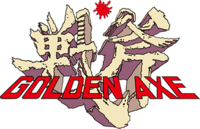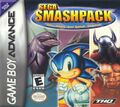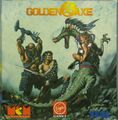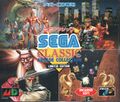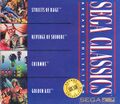Amstrad CPC[edit]
Developed by Probe and published by Virgin Games, Inc. in 1990.
-
Screenshot
-
Box art
Atari ST[edit]
Developed by Probe and published by Virgin Games, Inc. in 1990.
-
Screenshot
-
Box art
Commodore 64[edit]
Developed by Probe and published by Virgin Games, Inc. in 1990. Sadly, this version was limited to one enemy on screen at any time, making progress somewhat predictable and laborious. Players are also limited to a choice of either SFX or Music, but not both. While the SFX are terrible, the music is very passable. Graphics are decent too, but without the sheer number of enemies of either the arcade or other home versions, the C64 version really lacks a decent challenge.
-
Screenshot
-
Box art
-
MS-DOS/C64 (alternate)
Commodore Amiga[edit]
Developed by Probe and published by Virgin Games, Inc. in 1990. Despite the graphics not being as accurate as the MS-DOS version it was otherwise more faithful to the arcade original, and even included Alex's death scene (which all other versions depict through text).
-
Screenshot
-
Box art
Game Boy Advance[edit]
Developed by Sega and published by THQ, Inc. on September 24, 2002 as part of Sega Smash Pack (Game Boy Advance). This is a port of the Sega Genesis version, but further sacrifices have been made (for instance in the Sega Genesis version the king and princess were lowered to the ground while in this version they simply appear there). It also has no multiplayer.
-
Screenshot
-
Box art
Mega-Tech[edit]
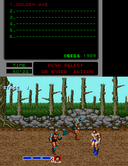
Developed and released by Sega in 1989. This is the Sega Genesis version running on Sega's Genesis-based Mega-Tech arcade hardware. Since the games were completely unaltered from their home equivalents players paid for time, not lives or credits.
Mobile[edit]
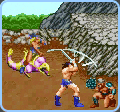
Released by Sega on May 1, 2008. Like many mobile games the screen space is limited, the controls poorly arranged and unresponsive, and the gameplay suffers from a noticeable amount of slowdown. There is no multiplayer.
MS-DOS[edit]
Ported by John and Kenn Sanderson and published by Sega in 1990. This version includes the usual home conversion features and a palette very similar to the arcade original (although the graphics themselves are still simplified). This version supported various types of graphics cards with varying degrees of graphics quality. There was also a "Super Golden Axe" bootleg that included a batch file to enable playing as enemies.
-
Screenshot
-
Box art
-
MS-DOS/C64 (alternate)
PC Engine Super CD-ROM²[edit]
Developed and released by Telenet. This version features anime-style cutscenes and CD-quality music, but the gameplay is not up to the same standards.
-
Screenshot
-
Box art
PlayStation 2/PlayStation Portable[edit]
Developed by Backbone Entertainment and released by Sega on November 7, 2006 as part of the Sega Genesis Collection. As the name implies, this is the Sega Genesis version running under emulation. Not to be confused with the Sega Ages 2500 Series Vol. 5: Golden Axe remake.
-
PlayStation 2 (Sega Genesis Collection)
-
PlayStation 2 (Sega Mega Drive Collection)
-
PlayStation Portable (Sega Genesis Collection)
-
PlayStation Portable (Sega Mega Drive Collection)
Sega CD[edit]
Developed and released by Sega in 1992 as part of Sega Classics Arcade Collection (and in 1993 as part of the five-game version of this compilation). This is mostly identical to the Sega Genesis version but features arcade-quality music taken from the official soundtrack. Unfortunately the enemy death cries have been replaced with new ones - enemies now say "ow!" (somewhat like Golden Axe II's "bleh!"). It is also a single player version.
-
Screenshot
-
Box art (European)
-
Box art (Japanese)
-
Mega CD (Sega Classic Arcade Collection)
-
Sega CD (Sega Classics Arcade Collection)
Sega Dreamcast[edit]
Developed and published by Sega on April 30, 2001 as part of Sega Smash Pack Volume 1. This is the Sega Genesis version running under emulation.
Unfortunately, while the gameplay remains faithful the Z80 sound emulation is completely broken, making the game sound not unlike the Sega Master System version.
-
Screenshot
-
Sega Dreamcast (Sega Smash Pack Volume 1)
Sega Genesis[edit]
Developed and published by Sega in 1989. The most well-known conversion, it sacrifices the rich palette and some graphical tweaks of the more powerful System 16 arcade hardware, but, like other home versions, it includes two additional stages and the new The Duel mode. Furthermore, there have been some slight modifications to the characters: Ax Battler has slightly longer reach with his sword attacks (in the arcade game, his sword-based attacks have the same reach as Tyris). This version was licensed by GameTap and made available running under emulation, in addition to the original arcade version.
-
Screenshot
-
Box art
-
Sega Genesis (Genesis 6-Pak)
-
Sega Mega Drive (Mega Games 2)
-
Sega Mega Drive (Mega Games 6)
-
Sega Mega Drive (Mega Games 10)
Sega Master System[edit]
Developed by Sega and published by Sega of America in 1990. This version did not feature the additional stages and modes of most home conversions. Instead of three characters there is only one, Tarik (a renamed Ax Battler), and the player can choose which of the three original characters' magic he uses. The game also features a tweaked storyline and additional artwork cutscenes. Unfortunately the actual game is plagued by an unstable framerate, uneven hit detection, and a dull palette. It also has no multiplayer, and lacks the additional modes and stages of other conversions.
-
Screenshot
-
Box art
Sinclair ZX Spectrum[edit]
Developed by Probe and published by Virgin Games, Inc. in 1990.
-
Screenshot
-
Box art
Tapwave Zodiac[edit]
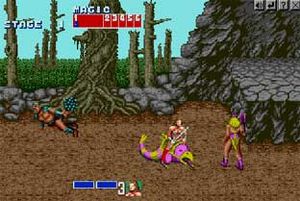
Developed by Sega and released by Lavastorm on January 1, 2004. This is the Sega Genesis version running under emulation. No multiplayer. Due to the differences in screen resolution between the two platforms this port provides a couple of stretch settings.
Windows 9x[edit]
Developed and published by Sega in 1998 as part of the Sega Smash Pack. This is the Sega Genesis version running under emulation, rather than the MS-DOS version.
-
Screenshot
-
Windows 9x (Sega Smash Pack)
-
Windows 9x (Sega Smash Pack Twin Pack)
WonderSwan Color[edit]
Developed and released by Bandai Co., Ltd. on February 28, 2002. This version includes additional difficulty levels.
-
Screenshot
-
Box art
Xbox Live Arcade[edit]
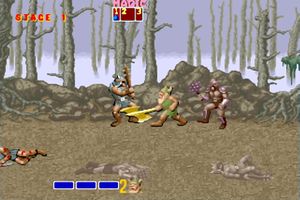
Released by Sega on July 10, 2007. This is an enhanced edition of the arcade version. As with other Xbox Live Arcade titles it includes optional graphics and sound improvement settings. It also includes online co-op via Xbox Live as well as 12 Achievements and trophies worth a total of 200 Gamer Points.
